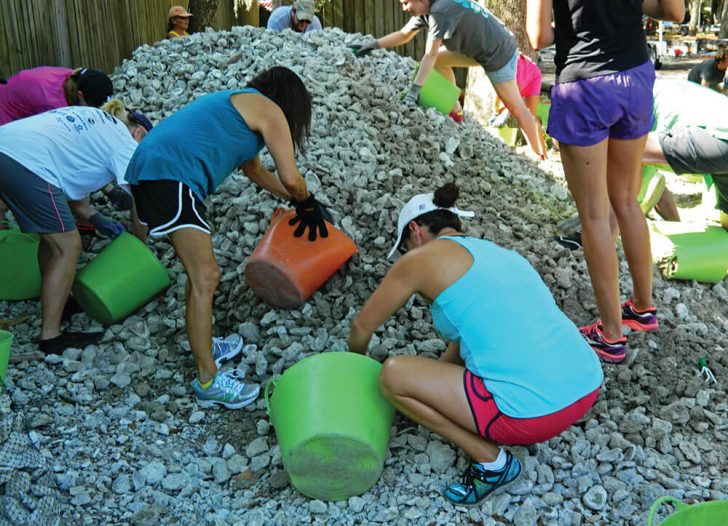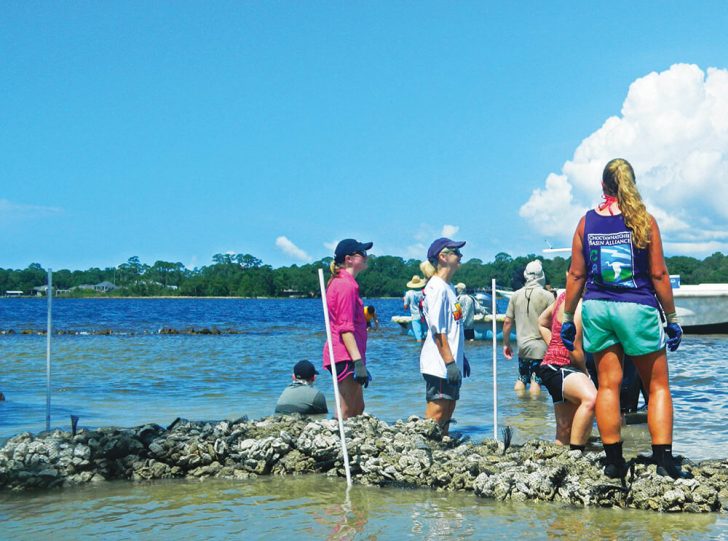By Erika Zambello:
Thigh-deep in the warm, brackish water of the Choctawhatchee Bay, volunteers stood in straight lines. Their arm-lengths connected a barge loaded down with bagged oyster shells to a partially completed oyster reef in Marina Cove, Niceville. Moving as one, volunteers from the barge handed off mesh bags stuffed with oyster shells to those standing in the water, each person then passed the bag like a hot potato to the next until finally the shells were placed in a brand new oyster reef.
After a year of effort, the 700-foot oyster reef—the largest the Choctawhatchee Basin Alliance (CBA) has ever constructed—was complete.
The journey for the oyster shells here closes a critical natural resource loop. In the past, people harvested oysters and sold them to seafood markets and restaurants. Once shucked and eaten, the shells were thrown away, destined for eternity in a landfill.
Alison McDowell, director of CBA, explained, “In a fully-functioning system, oyster larvae will settle on shells of adult oysters, attaching and growing to create ever-expanding oyster reefs that provide food and shelter to all sorts of creatures like fish, crab, and shrimp.”
Restaurants represent only one facet of oyster demand. McDowell continued, “In Choctawhatchee Bay, this habitat-building process was interrupted for most of the 20th century, as the oyster shell that provided the foundation for new oysters to settle was dredged and removed for commercial purposes like road beds and livestock feed.”
In 2010, CBA and their AmeriCorps Green Team launched an initiative to return the shell to the bay. Their O.Y.S.T.E.R. Shell Recycling Program collects oyster shells from local restaurants and dries them at CBA’s headquarters before bagging shells for use in oyster reef construction projects.
The new reef will join others CBA has constructed to provide critical habitat and other ecosystem services. The reef is a breakwater, as the structures protect the shoreline from erosion. The oysters are filter feeders, each individual improving water quality to the tune of 50 gallons each and every day. The improved water quality, in turn, can encourage the growth of seagrass and other submerged aquatic vegetation, providing additional habitat for fish. Moreover, the reef structures themselves shelter juvenile fish species. For example, Matt Wegener, a Florida Fish and Wildlife Conservation Commission biologist, explained that Redfish “use them for refuge from predation and foraging opportunities.”
“Mesh bags hold together all the shell, and the cracks and crevices provide hiding places for young fish,” Rachel Gwin, restoration coordinator for CBA, added. They’ve documented numerous varieties at their sites, from species in the goby and blenny families to shrimp.
In all, more than 200 volunteers worked on the reef’s construction, from the owners and staff of Bluewater Bay Marina to kids and families on National Marina Day to college students contributing hours during Alternative Spring Break. Through collecting and bagging the oyster shells, pushing the material in heavy dock carts to the barge, then laying the shell itself, the community came together to create habitat and improve water quality. To learn more, visit CBA at basinalliance.org.
Erika Zambello is a freelance writer and photographer who serves as communications coordinator for the Choctawhatchee Basin Alliance in northwest Florida.

